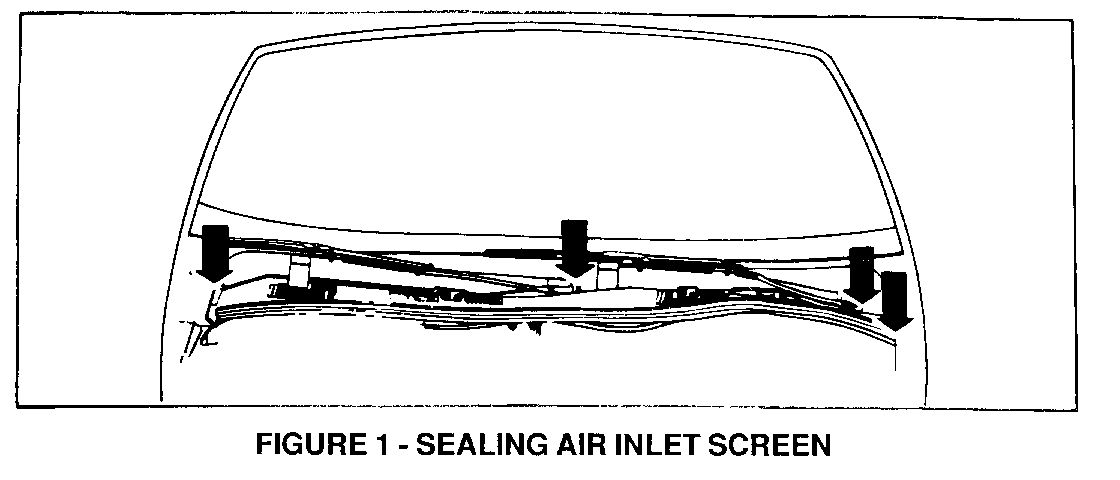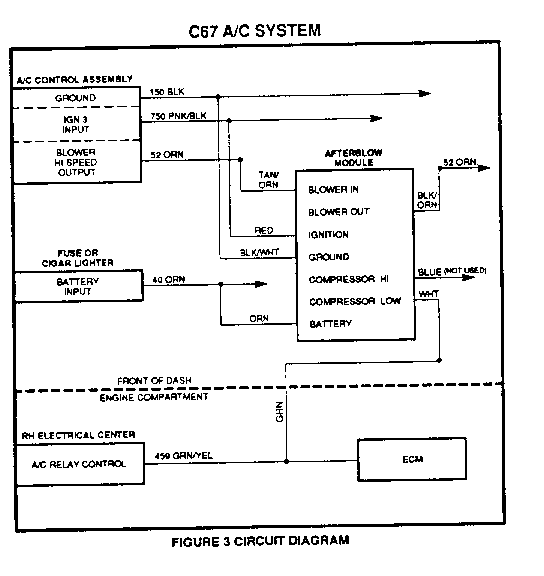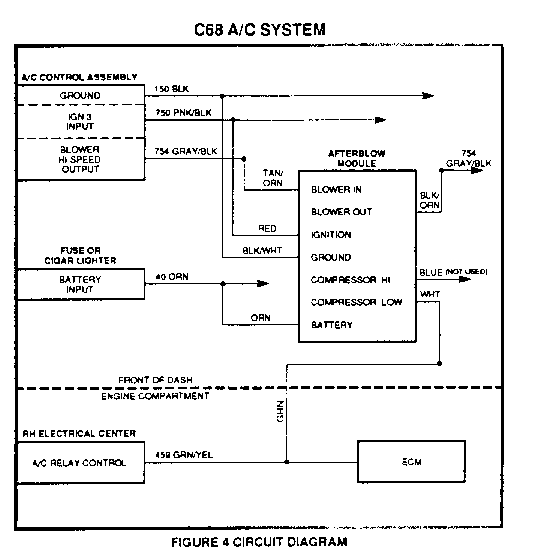A/C ODOR AT START UP CLEANING PROCEDURE OUTLINED

MODELS AFFECTED: 1988-90 REGALS
CONDITION:
Odors emitted from the Air Conditioning system primarily at start up in hot, humid climates.
CAUSE:
Debris in the heater/evaporator case and/or microbial growth on the evaporator core.
CORRECTION:
Clean the evaporator core and install an afterblow module, using the following equipment and procedure.
REQUIRED EQUIPMENT:
GM Goodwrench air conditioning system disinfectant kit P/N 25533404
Kent-Moore tool J-36645 air conditioning system cleaning gun
Rubber Gloves and Safety Goggles (ordinary safety glasses are not sufficient)
Pedestal Fan
Afterblow Module, P/N 25533406
A seven (7) ft. length of green 18 gage *electrical wire.
Parts are currently available from GMSPO.
*Purchase locally.
CAUTION:
Safety goggles must be worn. The disinfectant may cause substantial, but temporary, eye injury. Do not get in eyes or on clothing. Wash thoroughly with soap and water after handling.
FIRST AID:
If disinfectant gets into eyes, hold eyelids open and flush steady strea of water for fifteen (15) minutes. Obtain medical attention if irritatio persists.
PROCEDURE:
1. Raise vehicle and remove the rubber A/C drain tube.
2. Disconnect the negative battery cable.
3. Rotate and secure the engine in the forward service position as specified in the Service Manual, page 6A5-2 (1989-90), 6A3-7 (1988).
4. On 1988 and 89 vehicles, remove the upper attachments (Pal Nuts) of the secondary metal dash panel and pull the panel forward.
5. Remove the upper and side splash shields of the R.H. fender well for access to the R.H. electrical center and ECM.
6. Remove the A/C evaporator core from the vehicle. Use the appropriate Service Manual procedures on the removal of the evaporator core.
7. Check the heater/evaporator case and core for debris. Remove any debris that is present in the case or imbedded in the core. If a larg amount of debris is present in the case, the air inlet screen will require sealing around the windshield wiper post holes and fender edges, as shown in Figure 1.
8. Seal the inlet and outlet pipe ends of the evaporator core, using duct tape or plastic plugs if available.
9 Put on rubber gloves and safety goggles.
10. Pour the small bottle of A/C disinfectant kit, P/N 25533404, into the large bottle. Seal and invert the large bottle once or twice to mix contents.
11. Place the evaporator in a large sink, tub or basin.
12. Position a pedestal fan, as shown in Figure 2, and turn on high speed to provide cross ventilation during the cleaning of the evaporator core.
13. Use the Kent-Moore tool J-36645 or equivalent siphon-type cleaning spray gun capable of delivering two (2) ounces per minute of liquid when driven with shop air at 80-90 psi.
14. Direct the spray toward the evaporator core face, taking care to ensure adequate coverage of the corners and edges, completely saturating the entire core. Use the entire container of disinfectant.
15. Let the evaporator core soak for at least five (5) minutes.
16. If a tub or basin without a drain was used for the spraying of the disinfectant, remove the core and dispose of the disinfectant in a sanitary drain system. Rinse the tub or basin with water continuing on.
17. Use the spray gun and at least one (1) quart of clear water to rinse the evaporator core, to remove any and all of the disinfectant.
18. Allow the core to drain for a few minutes and then blow off the core with an air hose until core is dry. Remove tape or plugs from core pipes.
19. Reinstall the evaporator core into the vehicle. Do not install the lower heating A/C module cover at this time.
20. Before installing the lower heating A/C module cover, loosen the R.H. side of the foam seal around the drain tube and thread the green 18 gage electrical wire under the seal and pull approximately five (5) feet of the wire to the engine side of the drain seal.
21. Seal the bottom of the heating A/C module as specified in Bulletin Number 90-1-2.
22. Install the lower module cover threading the green wire into the engine compartment through the drain tube hole.
23. Install the remaining heating A/C module components. Do not install the dash components or close out panels at this time.
24. Route the green wire in the engine compartment along front of dash to R.H. side and then forward to the ECM. Secure the wire, with tie bands to the heater pipe across the front of the dash and to the existing wiring harness forward to the ECM. Use a small amount of RTV sealant to seal the green electrical wire at the breakpoint area of the A/C drain plug seal.
THE FOLLOWING STEPS ARE THE INSTRUCTIONS FOR THE INSTALLATION OF THE AFTERBLOW MODULE.
IMPORTANT:
The afterblow module will enable the blower to run at high speed for five (5) minutes approximately fifty (50) minutes after the vehicle ignition is turned off, if the compressor was engaged for four (4) minutes or more during the last ignition cycle.
IMPORTANT:
All the connections of the afterblow module harness to the vehicle wiring should be spliced, using the proper techniques shown in section 8A of the appropriate Service manual. The splices should be made using splice clips, solder and wrapping the splice with electrical tape. Do not use the instant connectors such as 3M-s SCOTCHLOK" brand.
IMPORTANT:
The circuit diagram shown in Figure 3, shows the circuit numbers generally used on the subject model year vehicles. However, to make sure of the correct circuits and wire colors are spliced into, refer to section BA of the Service Manual.
25. Disconnect the afterblow module from the jumper harness and set the module aside.
26. Splice the black/white wire (pin C) of the jumper harness into the black ground wire (circuit #150) in the black connector (cavity #12) of the A/C control assembly wiring.
27. Splice the red wire (pin B) of the jumper harness into the pink/black wire (circuit #750) of the black connector (cavity #4) of the A/C control assembly wiring.
28. Cut the orange blower Hi speed out put wire (circuit #52) of the black blower switch connector of the A/C control assembly wiring. Splice the tan/orange wire (pin F) of the jumper harness to the orange wire from the A/C control assembly. Splice the black/orange wire (pin G) of the jumper harness to the other end of the orange wire.
29. Splice the orange wire (pin A) of the jumper harness into the battery feed wire (circuit #40) at the fuse block or the cigar lighter. 30. Splice the end of the green wire, that is routed to the engine compartment to the white wire (Pin E) of the jumper harness.
31. In the engine compartment, splice the green wire into the green/yellow (Circuit #459) at either the A/C compressor relay (Cavity #1) of the R.H. electrical center or the ECM (Cavity A12).
32. Connect the negative battery cable.
33. Test the afterblow module, per the following procedure.
34. Cut off the bare end of the blue wire (Pin D) of the jumper harness, tape the end and fold and tape wire to the harness.
35. Mount the afterblow module in a convenient location under the dash using foam insulation as necessary to ensure a rattle-free installation of the module.
36. Install the secondary dash panel, the splash shields and return engine to its proper position.
37. Finish the installation of the dash components and close out panels.
TO TEST THE AFTERBLOW MODULE USE THE FOLLOWING PROCEDURE
1. Start the engine.
2. Turn the A/C system to engage the compressor.
3. Connect a jumper wire to apply battery voltage to the open cavity Pin H (Green Wire) of the afterblow module for at least thirty (30 seconds) with the compressor engaged.
4. Turn the ignition key off.
5. The blower should come on after approximately ten (10) seconds for one (1) second and then go off.
6. Disconnect the jumper wire.
NOTICE:
The afterblow module is not compatible with some non-factory installed theft alarm systems. The module current draw at key off position could trigger alarms that sense battery voltage changes or current drain.
ADVISE OWNER that the afterblow module will enable the blower motor to run at high speed for five (5) minutes approximately fifty (50) minutes after the vehicle ignition is turned off, if the A/C compressor was engaged for at least four (4) minutes or more during last ignition cycle.
WARRANTY INFORMATION:
Labor Operation: T6235
Labor Time: 2.8 Hours
If the air inlet screen needs to be sealed, use add time of 0.2 hours.




General Motors bulletins are intended for use by professional technicians, not a "do-it-yourselfer". They are written to inform those technicians of conditions that may occur on some vehicles, or to provide information that could assist in the proper service of a vehicle. Properly trained technicians have the equipment, tools, safety instructions and know-how to do a job properly and safely. If a condition is described, do not assume that the bulletin applies to your vehicle, or that your vehicle will have that condition. See a General Motors dealer servicing your brand of General Motors vehicle for information on whether your vehicle may benefit from the information.
